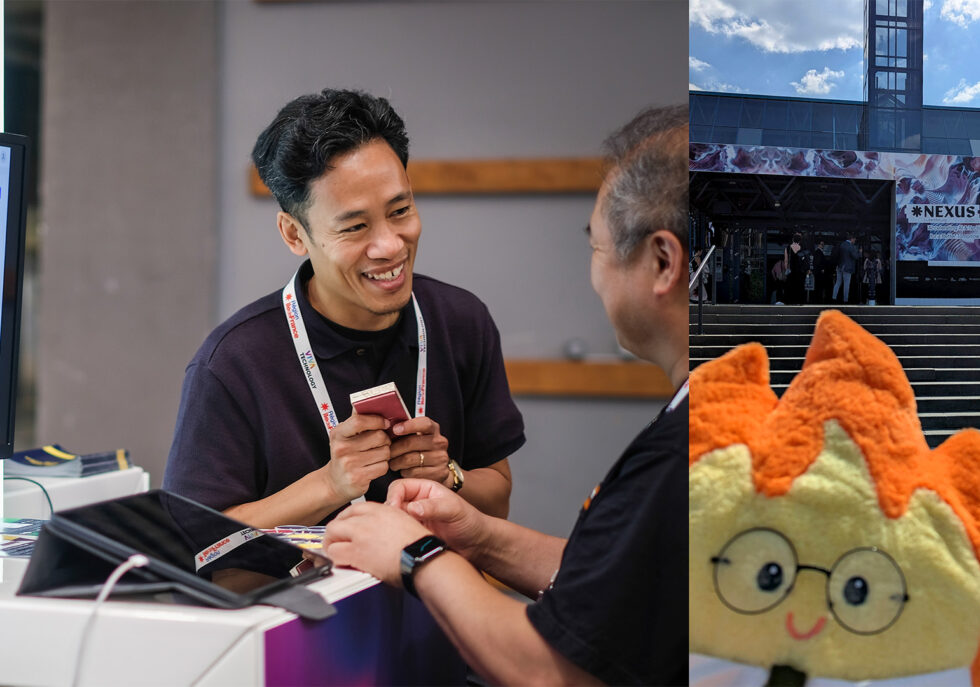Estimated reading time: 5 minutes
When you’re building a platform in agentic automation, you live between lines of code, decision logic, user testing, and the real world. It’s a constant balancing act between system architecture, UX finesse, and raw feedback.
That’s exactly what VivaTech 2025 and Nexus Luxembourg gave us: a full-scale reality check.
Two formats. Two tempos. Two truths.
And one common thread: nothing beats being in the field — because it’s the only place where your algorithm meets actual human behavior.
On paper, we model. In the field, we learn what breaks, what resonates, what moves people. The field doesn’t lie. It sharpens your assumptions. It forces decisions.
VivaTech Paris 2025: the arena.
The moment we walked in: scale overload. The noise, the flood of visitors, the electricity in the air.
Then — total surprise: our booth. On the corner of the Luxembourg pavilion, clean, well-placed, and professional. And it hit me: we’d be standing there for four days straight.
And I’ll be honest — I was nervous.
Hundreds of badges, people everywhere. I realized I’d have to talk to a ton of strangers.
That’s not my comfort zone.
So I started slow. One person. One card. One opener.
The first conversations were clumsy. I tried words, watched what landed, what confused people.
But conversation after conversation, the pitch started to evolve.
I realized I had more empathy than I thought. That “green side” of me kicked in — the part that listens for real. It helped me know when to end small talk, and when to dive deep into what Sendplex actually enables.
That’s when the shift happened — with Minh, right there on the floor:
→ As we explained what we do, we reshaped our MVP. It’s not a polished product or a prototype. It’s a flexible, adaptable platform that molds to the user.
→ As we listened to reactions, we discovered our true ICP — the kind of user who doesn’t just like what we’re building, but needs it. Not theory — real-world alignment.
That’s when we understood: our value isn’t in adding some AI layer on top of workflows.
It’s in offering a new way to orchestrate recurring tasks through autonomous agents designed as decision-making modules.
Systems that combine:
- Context management
- Traceable decision paths
- Human-in-the-loop interfaces
- Real business logic integrated into existing stacks
We’re not selling “intelligence.”
We’re selling a software architecture that redefines operational flow, with the human at the core.
Design, AI & the obsession with good signals
One more thing VivaTech made obvious: most AI products are glorified demos.
Pretty interfaces + LLM APIs = “product.”
But without contextual infra, observability, and data-driven supervision, these don’t scale.
At Miranki, we do it differently.
Design is our translator of intent.
Because without structure, content gets lost.
✅ UX focused on user intent, not UI aesthetics
✅ Modular design system for adaptability without breaking logic
✅ Task-oriented flows — not “tech showcases”
✅ Agents that don’t just respond — they collaborate
Our stack is built on hybrid architecture:
- Event-driven orchestrator
- Vector memory
- Human-in-the-loop interfaces
- Langchain-based modular agents
- And real data feedback loops to learn not just from what worked, but from what was avoided
That old saying “when there’s a will, there’s a way”?
It applies to system design too.
If you want your agent to be reliable, you have to plan for edge cases, failure modes, and undo paths — not just success stories.
The moments that stick
One name I can’t leave out: Willy Ayissi from Henddu.
His story — the setbacks, the pivots, the intensity — was a masterclass in real entrepreneurship.
And then, this other standout moment: teenagers, 14 or 15 years old, pitching their app in front of a packed audience.
They didn’t have all the answers — but they had momentum.
And I was reminded: audacity always comes before mastery.
Nexus Luxembourg: less noise, more signal.
Back home. Softer atmosphere. Familiar faces.
It felt like “we’ve heard this all before” — but that’s deceptive.
Because in this smaller setting, we caught the right signals.
→ What we’re building is right on time.
→ The weak signals we’d seen around agentic automation are now turning into major focus areas — even Facebook is talking about agentic superintelligence now.
Our booth wasn’t as polished.
But the conversations? Sharper. More grounded.
We planted the right seeds in the right places.
What we’re taking with us:
- Our pitch is a living system. It evolves with every conversation. It helps us rediscover our own value.
- Agent-based AI isn’t magic. It’s system design, deliberate orchestration, and clear technical choices. Built to be understood, not just impressive.
- Visibility is a strategy. Not a luxury. Especially when you’re not “ready.”
- Design isn’t style. It’s clarity. If your user doesn’t understand what your agent does, your product is dead.
Thinking of exhibiting next year?
→ Go to Nexus. Even if it’s smaller. You’ll validate, adjust, and connect with the right people.
→ Go to VivaTech. Even if it’s overwhelming. You’ll learn more in 72 hours than you could alone in six months.
“On to the next one.”
Not a mantra.
A method.









